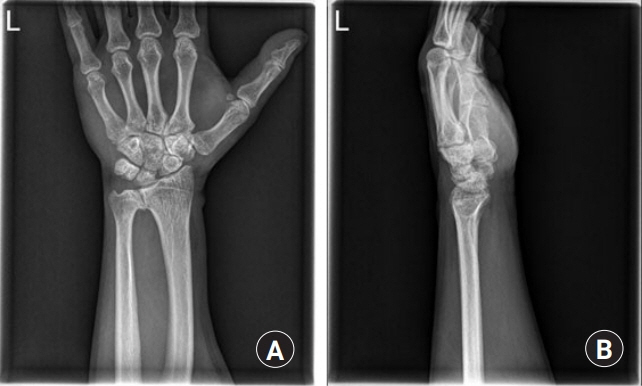Arch Hand Microsurg.
2020 Jun;25(2):124-127. 10.12790/ahm.20.0009.
Carpal Tunnel Syndrome due to Dorsal Intercalated Segmental Instability of the Wrist
- Affiliations
-
- 1Department of Orthopedic Surgery, Konyang University College of Medicine, Daejeon, Korea
- KMID: 2502708
- DOI: http://doi.org/10.12790/ahm.20.0009
Abstract
- Carpal tunnel syndrome (CTS) is the most common compressive neuropathy of the upper limb. Although most cases are idiopathic, it can occur due to various causes including an alteration of anatomical dimension of the carpal tunnel. CTS can be diagnosed mostly by clinical findings and electrodiagnostic test. As a result, the confirmation of structural change of carpal tunnel may be delayed as basic radiologic examinations such as simple radiography of the wrist are not performed. We confirmed carpal malalignment due to dorsal intercalated segmental instability on simple radiography of a patient with CTS whose symptoms did not improved by conservative managements. He had symptoms for more than 2 years, but had never undergone simple radiography of the wrist. Because structural changes of the carpal tunnel could be the main reason for CTS and affect the whole treatment process, the physician should always check standard radiography of the wrist before determining how to treat the patient.
Figure
Reference
-
1. Michelsen H, Posner MA. Medical history of carpal tunnel syndrome. Hand Clin. 2002; 18:257–68.
Article2. Karl JW, Gancarczyk SM, Strauch RJ. Complications of carpal tunnel release. Orthop Clin North Am. 2016; 47:425–33.
Article3. Ott F, Mattiassich G, Kaulfersch C, Ortmaier R. Initially unrecognised lunate dislocation as a cause of carpal tunnel syndrome. BMJ Case Rep. 2013; 2013:bcr2013009062.
Article4. Fowler JR, Cipolli W, Hanson T. A Comparison of three diagnostic tests for carpal tunnel syndrome using latent class analysis. J Bone Joint Surg Am. 2015; 97:1958–61.
Article5. Sears ED, Lu YT, Wood SM, et al. Diagnostic testing requested before surgical evaluation for carpal tunnel syndrome. J Hand Surg Am. 2017; 42:623–9.6. Monsivais JJ, Scully S. Rotary subluxation of the scaphoid resulting in persistent carpal tunnel syndrome. J Hand Surg Am. 1992; 17:642–4.
Article7. Fassler PR, Stern PJ, Kiefhaber TR. Asymptomatic SLAC wrist: does it exist? J Hand Surg Am. 1993; 18:682–6.
Article8. Kamihata S, Oda T, Wada T. Carpal tunnel syndrome and flexor tendon rupture in the wrist with asymptomatic scapholunate advanced collapse: a case report. J Hand Surg Asian Pac Vol. 2018; 23:589–92.
Article9. Miranda BH, Cerovac S. Spontaneous flexor tendon rupture due to atraumatic chronic carpal instability. J Wrist Surg. 2014; 3:143–5.
Article10. Hayashig M, Makoto M, Kato H. Carpal tunnel syndrome associated with underlying Kienbock's disease. J Hand Surg Eur Vol. 2015; 40:638–9.
- Full Text Links
- Actions
-
Cited
- CITED
-
- Close
- Share
- Similar articles
-
- Carpal Injuries
- Ulnar Neuropathy at the Wrist in a Patient with Carpal Tunnel Syndrome after Open Carpal Tunnel Release
- Causes of Residual Pain after Open Excision of Wrist Ganglion
- Trigger Wrist and Carpal Tunnel Syndrome Caused by a Fibroma of the Flexor Tendon
- Carpal Tunnel Syndrome Secondary to Tuberculous Tenosynovitis: A Case Report



